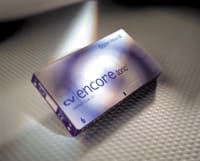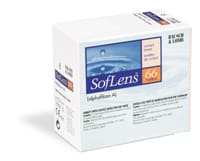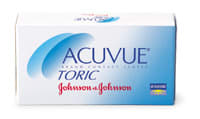Catching
the Drift of Toric Contact Lenses
Goodbye snowflake lenses, hello snowballing profits
By Barbara Anan Kogan, OD

"We were happy when the CSI lens became available because this soft, spherical contact lens masked some of the patient's cylinder," says Frank Fontana, OD, of St. Louis, Mo., a clinician on the studies for the first toric contact lenses.
While eyecare practitioners knew vision was being compromised by using 0.75D and 1.00D of cylinder to mask astigmatism, early problems duplicating the toric contact lens made for dispensing challenges, and the lenses were not wholeheartedly embraced.
However, notes Fontana, "CIBA's double slab-off toric contact lens was a real breakthrough." The new offering put the category on the road to success, and with all of the options available today in selecting and dispensing toric contact lenses, eyecare practitioners have a multitude of materials and designs from which to choose.
These choices "provide the patient with a healthier lens that works and motivates both the doctor and the patients," he says.
While technology has developed considerably over the years and new offerings are available all the time, making torics a part of day-to-day business at a dispensary can be an intimidating prospect. Following are tips for easing into this segment and boosting your bottom line with toric contact lenses.
COME IN FROM THE COLD
Last chance. Turning patients who've failed previously with torics into successful wearers has been a family tradition for third-generation optometrist Jim Day, OD, Birmingham, Ala.
Over the years, he and the other members of his family's practice have often seen the last-chance patients. "The number-one reason for toric contact lens failure was that colleagues did not address the patient's concerns," he says.
Too often minor physiological problems, such as blepharitis, meibomianitis, and ocular allergies could be cited as reasons for contact lens failure. By addressing the issues when they pop up, Day keeps his patients in their lenses and in comfort.
|
|
|
|
Cooper Vision's Encore toric contact lens |
|
Cost concerns. Custom lenses aren't cheap, and a common patient complaint is the cost of replacing torn custom torics.
Head this problem off at the pass by training patients in the special care required in the handling and treatment of toric contact lenses. With his patients, Day begins with "re-instructing toric wearers about how, from insertion to removal, to take care of their lenses, with special emphasis on the appropriate contact lens care solutions and how to use them."
Trial and error. Try and try again is the motto for Greg Leadingham, OD, a member of a family practice in Roswell, N.M.
Thanks to this positive attitude, torics generate approximately 30 percent of the practice's total contact lens income. But it is a time-consuming process, Leadingham notes: "Even though my father no longer practices full-time, he still fits toric lenses. If it can be done, we can fit the patient. This usually means trying three to four different brands, parameters, and modalities of torics."
That's what it takes to find what works best for a particular patient.
|
|
|
|
Ciba Vision's new toric daily disposable contact lens, Focus Dailies |
Extra time. About 25 percent of Craig Willoth, OD's contact lens business at his practice in Rochester, N.Y., is comprised of toric contact lenses because he puts in the hours.
"I make them feel a little more special and spend more time with the initial fitting of these contact lenses."
Simultaneously, he explains to patients that "it might take more time to achieve a successful and comfortable fitting lens because I may need to make adjustments in the contact lens."
The direct approach. Listen to your patients. If they want to wear contact lenses, don't try to steer them in another direction.
"Don't be afraid of torics, especially with so many parameters," says Ft. Lauderdale, Fla.-based Maria Casas, OD, adding, "With astigmatic patients really wanting to wear contacts, instead of discouraging the patient, go straight for the torics."
EXPLAINING TORICS
Letting your patients know what they're getting is key to fitting them with a toric lens.
As an alternative to the conventional football versus an orange analogy, Fontana explains the astigmatic eye in greater detail for more understanding.
|
|
|
|
Bausch & Lomb's SofLens 66 toric lens |
|
"You have astigmatism, which means the shape of your eyes has different curves going up and down from those going sideways," he says. "We can correct the nearsightedness or farsightedness as well as the astigmatism, so that you do not have to suffer from any compromised vision."
Once the patient understands the concept of astigmatism, the topic of torics can be introduced and toric contact lens discussions can follow from there.
Take a pair of glasses and slowly twist them until completing a 90-degree rotation, Willoth suggests. Then you will be able to lead into the contact lens issue from there with a statement such as, "The optical lab turns your lens until it matches the location in the curves of your eye. A contact lens lab has special designs for specific astigmatic directions, and when combined with a number of measurements I provide them, they manufacture a contact lens that will stay in one place in your eye."
FITTING TIPS
Who should wear toric contact lenses and in what situations the lenses will work best are prime considerations. The eyecare practitioners we spoke with make the following recommendations.
Rx guidelines. Each of the optometrists interviewed for this report recommends torics if a patient has a minimum of 0.75D of cylinder, and most will fit up to 3.00 or 3.50D as a maximum limit.
Sports use. "A big advantage with the disposable toric contact lens is for the athlete who scuba dives or skis," says Day.
Those involved in other sports can benefit from toric contact lenses as well, particularly when used with supplementary eyewear. For his skiing and golfing patients, Willoth recommends torics for use with sunglasses or ski goggles.
Trial lenses. The four-lens approach, used by Day, involves placing two trial lenses on the eyes to identify which is the most stable in the six o'clock position.
If necessary, an additional two lenses can be trial fitted prior to ordering.
Spare pair. A spare pair of torics is practical, says Casas. She often selects frequent replacement or disposable toric contact lenses to serve as the alternate pair.
Follow up. The follow-up objective evaluation for each of the lens' parameters is just as important as the subjective evaluation about lens awareness and visual clarity.
"It is not uncommon at this follow-up appointment to reorder a custom toric that can provide better control on the lenses' base curve and diameter," Day says.
"Trial lenses are best evaluated after two weeks," says Fontana. He adds that this attention to detail during follow-up examinations alleviates the patient's fear of "getting stuck with an expensive contact lens that doesn't work."
Another fitting philosophy is to evaluate the patient after he or she sits with the trial lenses on for 15 to 20 minutes. If the patient achieves a 20/25 visual acuity, Casas dispenses the contact lenses and schedules a one-week follow up where patients can provide feedback.
"I want to see how the contact lens is performing and hear from the patient about how the lens is working," she says.
|
|
|
|
Acuvue Toric contact lenses from Vistakon |
Higher fee. Charging a higher professional fee can be justified by the high quality of service provided to toric wearers, as well as the fact that toric patients often require more chair time.
This can mean a set toric contact lens fitting fee of up to twice that of spherical contact lenses--quite a boost to the bottom line. A toric contact lens fitting can be "much more difficult. It might take more time to make all of the necessary adjustments," says Willoth.
Finally, you can start getting the message to patients before the exam begins. For example, an introduction to toric contacts can play on the telephone instead of hold music.
Another option is including information in appointment recall notices about a practice's ability to help astigmatic patients. More information can be provided when the patient is in the exam chair for the initial evaluation or the follow-up visits.
Working with torics sets you apart from other eyecare practitioners, and when happy toric contact lens wearers refer others to your office for care, your practice will grow.







